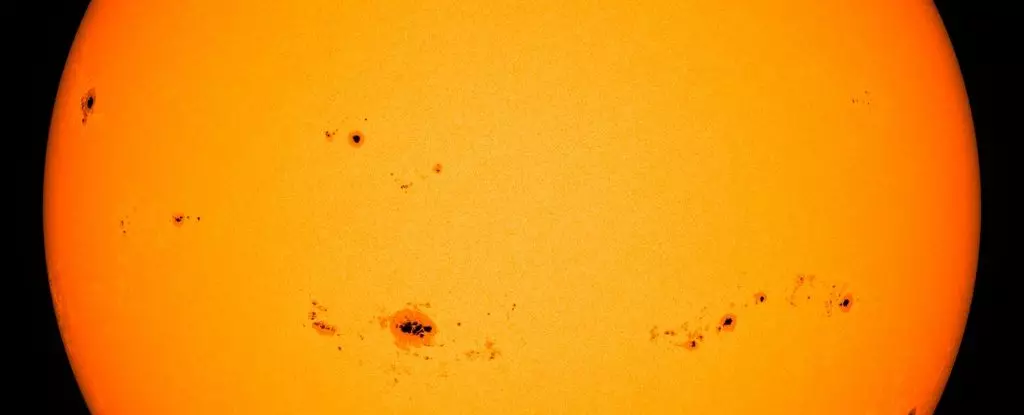Recent announcements from NASA, the National Oceanic and Atmospheric Administration (NOAA), and the Solar Cycle Prediction Panel are making headlines: the solar maximum phase of the Sun’s 11-year activity cycle has officially commenced. This significant period indicates a heightening in solar activity, characterized by an increase in sunspots, solar flares, and coronal mass ejections (CMEs). As this astronomical phenomenon unfolds, we can expect more pronounced solar activity in the coming months. However, a complete understanding of when this peak will occur remains elusive, with experts predicting that this peak will not be pinpointed until well after the solar maximum phase has passed.
Meteorologist Elsayed Talaat of NOAA emphasizes the uncertainty surrounding solar activities, stating that simply reaching this phase does not guarantee a synchronized peak within the current cycle. The effects of solar maximum are profound, yet the exact timing and strength of solar activity are challenging to forecast.
The Mysteries of Solar Dynamics
The Sun’s behavior during its activity cycle has captivated scientists for centuries, illustrating that, despite being a stable and central figure in our solar system, it is anything but constant. The intricacies of the solar dynamo, the engine behind magnetic activity that gives rise to phenomena like sunspots and solar flares, remain one of the most perplexing challenges in astrophysics. Although it is established that the solar cycle averages about 11 years, individual cycles can differ significantly in duration and intensity. The unpredictable nature of these cycles raises the question of how well we can forecast future solar events accurately.
Michael Wheatland, a solar astrophysicist from the University of Sydney, conveyed this sentiment through his assertion that our predictive abilities regarding solar cycles are still limited. Making progress in unraveling the internal mechanisms of the Sun is crucial to enhancing our prediction models.
One of the primary indicators of solar activity is the presence of sunspots on the Sun’s surface. These cool, dark regions are created when strong magnetic fields inhibit the motion of hot plasma, leading to localized areas of lower temperature. The solar cycle can be divided into two phases: solar minimum, characterized by the fewest sunspots, and solar maximum, when these sunspots proliferate across the solar landscape.
The connection between sunspots and other explosive solar phenomena, like solar flares, is well established. When magnetic fields in sunspots become unstable, they can snap and reconnect, resulting in immense bursts of energy. Similarly, CMEs can occur, releasing massive quantities of solar particles and magnetic fields into space. The resulting interactions with Earth’s magnetic field can yield geomagnetic storms, capable of disrupting modern technology, including power grids, communication systems, and satellite operations.
The Earth’s Response to Solar Activity
While the hazards posed by solar flares and CMEs are concerning, there are also beautiful consequences of solar activity. The charged particles emitted during these solar events can interact with the Earth’s atmosphere, creating stunning displays of auroras, primarily visible in higher latitudes. This year has been notable for the frequency and intensity of aurora sightings, prompting both scientists and skywatchers to marvel at nature’s light shows.
It’s essential to note that despite the heightened activity predicted for this solar cycle, current projections suggest that the ongoing cycle is not the most severe on record. The recent October X9.0 solar flare, while noteworthy, ranks highly among recorded eruptions, yet it is far from being the most potent flare observed in our Sun’s history.
As researchers sift through the data generated during this solar maximum, they are eager to enhance their understanding of solar dynamics and activity. While predictions for the strength of this cycle exceeded initial forecasts by NASA and NOAA, there remains a faction of scientists who anticipated a robust cycle with remarkable accuracy. This discrepancy offers intriguing implications for refining solar cycle models and may lead to breakthroughs in solar astrophysics.
As we navigate this period of increased solar activity, the focus on solar studies is more critical than ever. The sun, while constant in its role as the centerpiece of our solar system, continues to exhibit behaviors that challenge our understanding and predictive capabilities. With potential disruptions to technology and mesmerizing auroral displays, solar maximum is a time of both excitement and caution for Earth’s inhabitants. As we brace for the effects of the Sun’s powerful forces, science marches forward in its quest to decipher the mysteries of this magnificent celestial body.

Leave a Reply